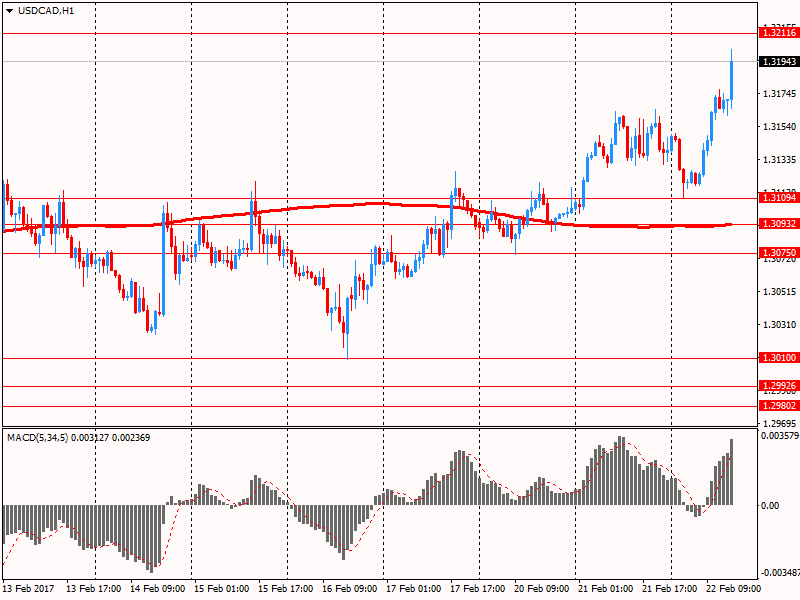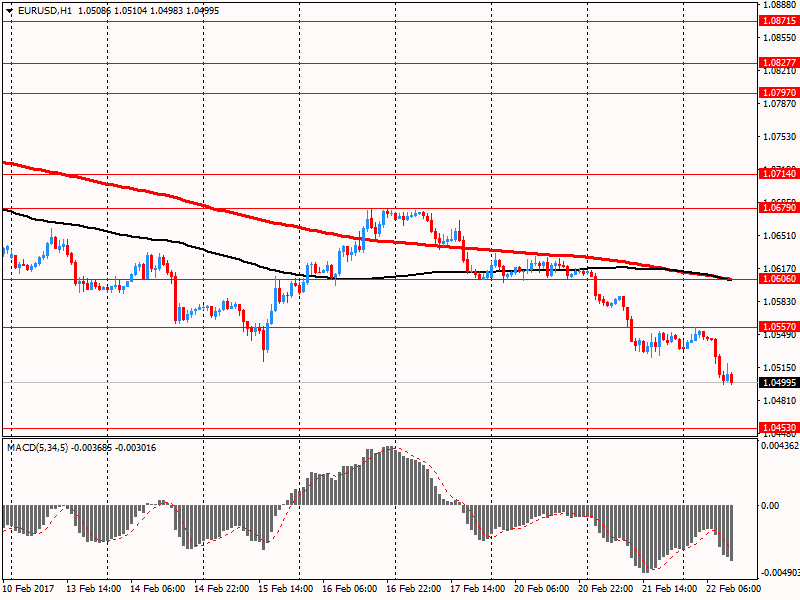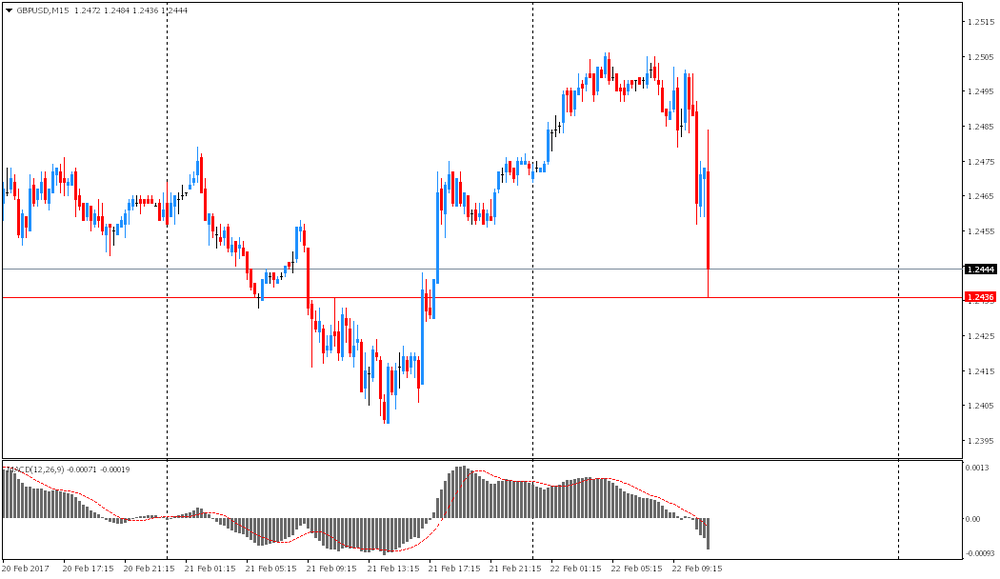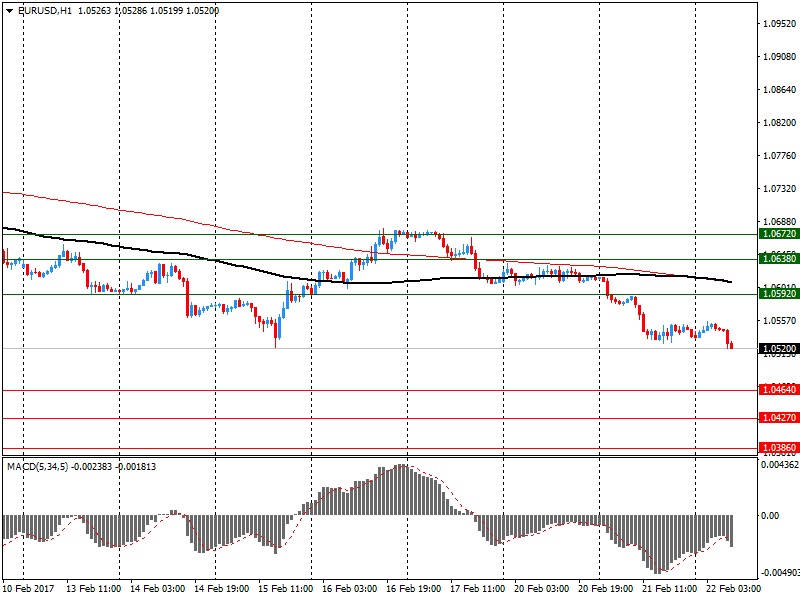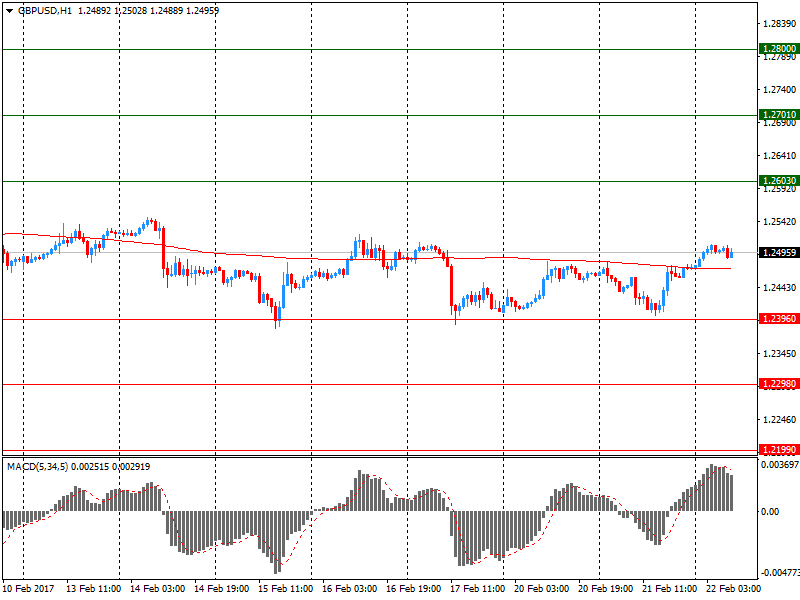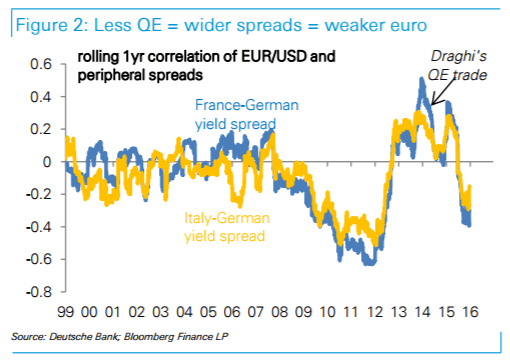Market news
-
23:27
Currencies. Daily history for Feb 22’2017:
(pare/closed(GMT +2)/change, %)
EUR/USD $1,0558 +0,22%
GBP/USD $1,2447 -0,21%
USD/CHF Chf1,0101 +0,07%
USD/JPY Y113,30 -0,32%
EUR/JPY Y119,61 -0,13%
GBP/JPY Y141,01 -0,55%
AUD/USD $0,7700 +0,35%
NZD/USD $0,7188 +0,40%
USD/CAD C$1,3162 +0,17%
-
22:59
Schedule for today, Wednesday, Feb 23’2017 (GMT0)
00:30 Australia Private Capital Expenditure Quarter IV -4.0% -0.5%
05:00 Japan Leading Economic Index (Finally) December 102.6 105.2
05:00 Japan Coincident Index (Finally) December 115
07:00 Germany GDP (QoQ) (Finally) Quarter IV 0.1% 0.4%
07:00 Germany GDP (YoY) (Finally) Quarter IV 1.5% 1.6%
07:00 Germany Gfk Consumer Confidence Survey March 10.2 10.1
08:15 Switzerland Industrial Production (YoY) Quarter IV 0.4%
11:00 United Kingdom CBI retail sales volume balance February -8 5
13:30 U.S. Continuing Jobless Claims 2076 2065
13:30 U.S. Initial Jobless Claims 239 242
14:00 U.S. Housing Price Index, m/m December 0.5% 0.4%
16:00 U.S. Crude Oil Inventories February 9.527
22:30 Australia RBA's Governor Philip Lowe Speaks
-
15:35
Denmark's central bank says as of 1 march 2017, the 10-year nominal on-the-run issue, 0.5 per cent bullet loan 2027, becomes the new 10-year benchmark bond
-
15:14
US existing home sales rose more than expected in January
Existing-home sales stepped out to a fast start in 2017, surpassing a recent cyclical high and increasing in January to the fastest pace in almost a decade, according to the National Association of Realtors. All major regions except for the Midwest saw sales gains last month.
Total existing-home sales, which are completed transactions that include single-family homes, townhomes, condominiums and co-ops, expanded 3.3 percent to a seasonally adjusted annual rate of 5.69 million in January from an upwardly revised 5.51 million in December 2016. January's sales pace is 3.8 percent higher than a year ago (5.48 million) and surpasses November 2016 (5.60 million) as the strongest since February 2007 (5.79 million).
-
15:00
U.S.: Existing Home Sales , January 5.69 (forecast 5.55)
-
14:15
The National Bank of Belgium’s business barometer has dropped in February
This is the first time it has deteriorated since August 2016.
It was only in the manufacturing industry that business confidence weakened. In the trade and building sectors, the business cycle actually picked up a little. And lastly, in business-related services, the economic climate stabilised in February, after having improved for four months in a row.
The downturn in the manufacturing indicator is primarily attributable to an unfavourable assessment of total order books and stock levels.
The slight recovery of confidence in the retail trade sector is due to considerably more optimistic expectations regarding employment.
-
13:59
Belgium: Business Climate, February -1.1 (forecast 0.8)
-
13:45
Option expiries for today's 10:00 ET NY cut
EURUSD: 1.0500 (EUR 301m) 1.0600 (373m)
USDJPY: 114.00 (USD 259m)
GBPUSD: 1.2300 (GBP 400m)
AUDUSD: 0.7685 (AUD 204m) 0.7750 (356m)
EURNOK: 8.8000 (EUR 822m), 8.8500 (530m)
-
13:42
-
13:32
Following four consecutive monthly increases, Canadian retail sales decreased 0.5% in December
Declines were widespread as lower sales were reported in 9 of 11 subsectors, representing 82% of retail trade.
After removing the effects of price changes, retail sales in volume terms decreased 1.0%.
After three consecutive monthly gains, sales at motor vehicle and parts dealers were down 0.9%. Lower sales at new car dealers accounted for the decline at the subsector level, more than offsetting gains at all other store types. Following an 11.4% decline in November, sales at automotive parts, accessories and tire stores bounced back in December, rising 18.2%. Sales at other motor vehicles dealers (+5.0%), which include snowmobile dealers, were up for the fifth consecutive month. Used car dealers (+1.6%) also reported higher sales in December.
Food and beverage stores registered a 0.4% decrease in December. Lower sales at beer, wine and liquor stores (-3.6%) more than offset gains in October and November. Higher receipts at supermarkets and other grocery stores (+0.4%) and specialty food stores (+0.8%) were mainly due to higher volumes, as food prices were down in December.
-
13:30
Canada: Retail Sales, m/m, December -0.5% (forecast 0.1%)
-
13:30
Canada: Retail Sales ex Autos, m/m, December -0.3% (forecast 0.6%)
-
13:30
Canada: Retail Sales YoY, December 4.3%
-
13:16
Kremlin aide Ushakov says Russia, U.S. not in talks on date for first Putin-Trump meeting
-
13:10
EU says Italy must adopt measures to comply with debt rules
-
13:00
Orders
EUR/USD
Offers 1.0520 1.0550 1.0580 1.0600 1.0620 1.0635 1.0650
Bids 1.0500 1.0480-85 1.0450 1.0430 1.0400
GBP/USD
Offers 1.2500 1.2520 1.2550 1.2575-80 1.2600
Bids 1.2480 1.2465 1.2450 1.2415-20 1.2400 1.2380 1.2345-50
EUR/GBP
Offers 0.8430 0.8450 0.8480 0.8500 0.8520 0.8535
Bids 0.8400 0.8385 0.8350 0.8330 0.8300
EUR/JPY
Offers 119.30 119.50 119.85 120.00 120.30 120.50
Bids 118.80 118.50 118.30 118.00 117.50 117.00
USD/JPY
Offers 113.50 113.80-85 114.00-05 114.20 114.35 114.50
Bids 113.20 113.00 112.80 112.50 112.30 112.00
AUD/USD
Offers 0.7720 0.7735 0.7750 0.7780 0.7800
Bids 0.7680 0.7665 0.7650 0.7620 0.7600
-
12:07
-
11:30
Sweden sells 2025 bonds at average yield 0.37 debt office
-
10:02
Euro area inflation confirms preliminary release
Euro area annual inflation was 1.8% in January 2017, up from 1.1% in December 2016. In January 2016 the rate was 0.3%. European Union annual inflation was 1.7% in January 2017, up from 1.2% in December. A year earlier the rate was 0.3%. These figures come from Eurostat, the statistical office of the European Union.
In January 2017, the lowest annual rates were registered in Ireland (0.2%), Romania (0.3%) and Bulgaria (0.4%). The highest annual rates were recorded in Belgium (3.1%), Latvia and Spain (both 2.9%), and Estonia (2.8%). Compared with December 2016, annual inflation fell in two Member States and rose in twenty-six.
-
10:00
Eurozone: Harmonized CPI, January -0.8% (forecast -0.8%)
-
10:00
Eurozone: Harmonized CPI, Y/Y, January 1.8% (forecast 1.8%)
-
10:00
Eurozone: Harmonized CPI ex EFAT, Y/Y, January 0.9% (forecast 0.9%)
-
09:58
-
09:40
Sentiment among German managers improved this month - Ifo
The Ifo Business Climate Index rose to 111.0 points in February from 109.9 (seasonally adjusted) points last month. Assessments of the current business situation reached their highest level since August 2011. Companies also expressed greater optimism about the months ahead. After making a cautious start to the year, the German economy is back on track.
In the manufacturing sector, the index rose. Manufacturers were far more satisfied with their current business situation. After deteriorating in January, the business outlook also brightened slightly. Current demand and the number of incoming orders picked up markedly. This positive development was mainly driven by food producers, as well as mechanical and electrical engineering firms.
-
09:33
UK business investment down 1.0% in Q4 2016
Gross fixed capital formation (GFCF), in volume terms, was unchanged at £78.0 billion, in Quarter 4 (Oct to Dec) 2016, when compared with Quarter 3 (July to Sept) 2016.
Between Quarter 3 2016 and Quarter 4 2016, business investment, in volume terms, was estimated to have decreased by 1.0%, from £44.0 billion to £43.5 billion.
Between Quarter 4 2015 and Quarter 4 2016, GFCF was estimated to have increased by 0.9%, from £77.3 billion to £78.0 billion.
Business investment was estimated to have decreased by 0.9% between Quarter 4 2015 and Quarter 4 2016, from £43.9 billion to £43.5 billion.
Between 2015 and 2016, GFCF was estimated to have increased by 0.5%, an increase of £1.4 billion.
-
09:31
UK GDP rose more than expected in Q4
UK gross domestic product (GDP) in volume terms was estimated to have increased by 0.7% between Quarter 3 (July to Sept) 2016 and Quarter 4 (Oct to Dec) 2016, revised up 0.1 percentage points from the preliminary estimate of GDP published on 26 January 2017. Upward revisions (due to later data received) within the manufacturing industries is the main reason (these revisions were first published as part of the Index of Production for December 2016 released on 10 February 2017).
UK GDP growth in Quarter 4 2016 saw a continuation of strong consumer spending which is in line with the Retail Sales Index for Quarter 4, which grew by 1.2% (published on 20 January 2017) and strong growth in the output of the services sector with a notable contribution in consumer-focused industries. In Quarter 4 2016, there has been a slowdown within business investment which fell by 1.0%, driven by subdued growth within the "ICT equipment and other machinery and equipment" assets.
-
09:30
United Kingdom: GDP, q/q, Quarter IV 0.7% (forecast 0.6%)
-
09:30
United Kingdom: GDP, y/y, Quarter IV 2% (forecast 2.2%)
-
09:01
Germany: IFO - Expectations , February 104 (forecast 103)
-
09:01
Germany: IFO - Expectations , February 104 (forecast 103)
-
09:00
Germany: IFO - Current Assessment , February 118.4 (forecast 116.7)
-
09:00
Germany: IFO - Business Climate, February 111 (forecast 109.6)
-
08:16
ECB says 177 mln euros borrowed using overnight loan facility, 480.225 bln euros deposited
-
08:11
Today’s events
-
At 10:30 GMT Germany will hold an auction of 30-year bonds
-
At 11:00 GMT the Bank of England Deputy Governor for Financial Stability John Cunliffe deliver a speech
-
At 18:00 GMT FOMC member Jerome Powell will deliver a speech
-
At 19:00 GMT publication of the Fed meeting minutes
-
At 20:00 GMT Deputy Governor of the Bank of England Nemat Shafik will deliver a speech
-
-
07:32
Options levels on wednesday, February 22, 2017
EUR/USD
Resistance levels (open interest**, contracts)
$1.0672 (3000)
$1.0638 (3482)
$1.0592 (1953)
Price at time of writing this review: $1.0520
Support levels (open interest**, contracts):
$1.0464 (4844)
$1.0427 (3320)
$1.0386 (4241)
Comments:
- Overall open interest on the CALL options with the expiration date March, 13 is 72516 contracts, with the maximum number of contracts with strike price $1,0800 (4763);
- Overall open interest on the PUT options with the expiration date March, 13 is 83501 contracts, with the maximum number of contracts with strike price $1,0550 (5594);
- The ratio of PUT/CALL was 1.15 versus 1.22 from the previous trading day according to data from February, 21

GBP/USD
Resistance levels (open interest**, contracts)
$1.2800 (3024)
$1.2701 (2445)
$1.2603 (2284)
Price at time of writing this review: $1.2496
Support levels (open interest**, contracts):
$1.2396 (1651)
$1.2298 (3269)
$1.2199 (1514)
Comments:
- Overall open interest on the CALL options with the expiration date March, 13 is 33890 contracts, with the maximum number of contracts with strike price $1,2800 (3024);
- Overall open interest on the PUT options with the expiration date March, 13 is 35700 contracts, with the maximum number of contracts with strike price $1,2300 (3269);
- The ratio of PUT/CALL was 1.05 versus 1.07 from the previous trading day according to data from February, 21

* - The Chicago Mercantile Exchange bulletin (CME) is used for the calculation.
** - Open interest takes into account the total number of option contracts that are open at the moment.
-
07:27
Fitch on Singapore - expects GDP growth to remain close to 2% in 2017
-
Higher spending and smaller budget surplus planned for next year do not pose a risk to Singapore's sovereign credit profile
-
Expansionary Singapore budget targets structural issues
-
-
07:20
Deutsche Bank says ECB taper is not necessarily bullish for EUR
"One of the pushbacks we get to our weaker euro view is that the ECB will signal tapering this year preventing EUR/USD weakness. We don't agree.
First, tapering is not necessarily bullish for a currency. When the Fed signaled taper in mid-2013 the dollar strengthened a lot against EM but it weakened against both the euro and yen.
Second, ECB tightening is not that simple. Not only would it steepen curves but it risks a return of redenomination risk that has been conveniently compressed by the ECB's fight against deflation.
Finally, EUR/USD is not just about the ECB but also the Fed and the level of US yields...With the dollar having transitioned to a high-yielder and even more Fed hikes to come, the greenback should be doing a good job of attracting inflows and deflecting its use as a funding currency to both the euro and the yen.
The dollar has had a tough start to start the year but we are not giving up on our bullish view for 2017".
Copyright © 2017 DB, eFXnews™
-
07:14
Total construction work done in Australia fell 2.5% in the last quarter of 2016
The trend estimate for total construction work done fell 2.5% in the December quarter 2016.
The seasonally adjusted estimate for total construction work done fell 0.2% to $46,263.5m in the December quarter.
The trend estimate for total building work done fell 0.6% in the December quarter.
The trend estimate for non-residential building work done fell 1.7% and residential building work was flat.
The seasonally adjusted estimate of total building work done rose 1.3% to $26,695.2m in the December quarter.
-
07:13
Australian Wage Price Index rose 1.9 per cent through the year
The seasonally adjusted Wage Price Index (WPI) rose 1.9 per cent through the year to the December quarter 2016, according to figures released today by the Australian Bureau of Statistics (ABS). This result equals the record low wages growth recorded in the September quarter 2016.
Seasonally adjusted, private sector wages rose 0.4 per cent and public sector wages grew 0.6 per cent in the December quarter 2016.
-
07:11
BoJ Gov Kuroda: More Easing Possible If Required To Meet Price Target, Chances Are Small re: Further Rate Cut - Reuters
-
00:30
Australia: Construction Work Done, Quarter IV -0.2% (forecast 0.3%)
-
00:30
Australia: Wage Price Index, q/q, Quarter IV 0.5% (forecast 0.5%)
-
00:30
Australia: Wage Price Index, y/y, Quarter IV 1.9% (forecast 1.9%)
-
